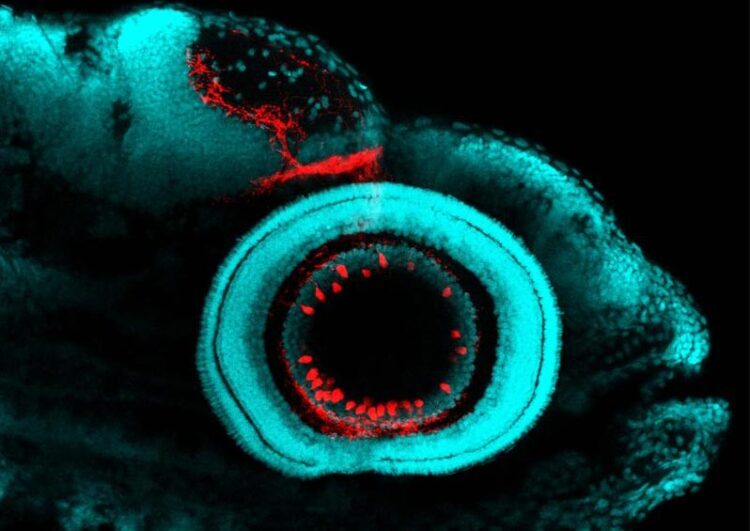Tracing the many paths of vision

The catalog allowed studying individual cell types in the retina and linking them to a specific structure, function and behavioral response.
Credit: MPI of Neurobiology / Koelsch
New study decodes the molecular diversity of neurons in the zebrafish retina.
Retinal ganglion cells (RGCs) are the bottleneck through which all visual impressions flow from the retina to the brain. A team from the Max Planck Institute of Neurobiology, University of California Berkeley and Harvard University created a molecular catalog that describes the different types of these neurons. In this way, individual RGC types could be systematically studied and linked to a specific connection, function and behavioral response.
When zebrafish see light, they often swim towards it. Same with prey, although the signals are entirely different. A predator, on the other hand, prompts the fish to escape. That’s good, because a mix-up would have fatal consequences. But how does the brain manage to react to a visual stimulus with the proper behavior?
Optical signals are generated by photons that bombard the retina of the eye. Neurons in the retina collect and process these impressions. While doing so, the retina focuses on the important details: Is there contrast or color? Are there small or large objects? Is something moving? Once these details are filtered out, retinal ganglion cells (RGCs) send them to the brain, where they are translated into a specific behavior.
As the only connection between the retina and the brain, RGCs play a central role in the visual system. We already knew that specific RGC types sends different details to different regions of the brain. However, it has been unclear how RGC types differ on the molecular level, what their respective functions are, and how they help to regulate context-dependent behavior.
To begin to solve this puzzle, a team led by Yvonne Kölsch from Herwig Baier’s laboratory analyzed the genetic diversity of RGCs. Collaborating with the groups of Joshua Sanes (Harvard University) and Karthik Shekhar (UC Berkeley), they determined the transcriptomes, i. e., the patterns of all active genes, in RGCs and thereby assigned each cell its own unique molecular fingerprint. A computational analysis of the large scale dataset comprising >30,000 RGCs identified at least 32 different RGC types based on similarities.
Cell type specific genes
In this new catalog of neuronal cell types, the scientists found genes that are only active in certain RGC types. With the help of these genes and targeted genome editing, they gained genetic access to selected RGC types – the prerequisite for studying their structure and function.
In the almost transparent zebrafish, it was thus possible to fluorescently label RGC types and to record in which brain regions their axonal projections end. It was also possible to determine which visual detail a RGC type prefers. To do this, the researchers showed fish larvae various visual stimuli and investigated which of them activate a particular cell type. For example, one RGC type reacted to light, but not to the simulation of an attacking predator.
What does it mean for the fish’s behavior if this cell type no longer functions? Normally, fish larvae prefer a bright environment in which they can perceive their surroundings and easily find food. When the scientists inactivated the above cell type measuring light conditions, the fish lost their ability to navigate to their favorable environment – a clear sign that the RGC type is especially important for approaching light.
Highly specialized genes
The analysis links a molecularly described RGC type to a specific structure, function and behavioral response. It also shows how specialized individual RGC types are – from the brain regions they contact to their role in behavior. This finding supports the theory that highly specialized neuronal circuits are the brain’s secret to translating diverse visual stimuli into proper behavior.
In the future, the molecular catalog will allow to systematically investigate other RGC types. The study thus takes us a decisive step forward in gaining a comprehensive understanding of the functional architecture of the visual system.
###
Original publication
Yvonne Kölsch, Joshua Hahn, Anna Sappington, Manuel Stemmer, António M. Fernandes, Thomas O. Helmbrecht, Shriya Lele, Salwan Butrus, Eva Laurell, Irene Arnold-Ammer, Karthik Shekhar, Joshua R. Sanes and Herwig Baier
Molecular classification of zebrafish retinal ganglion cells links genes to cell types to behavior
Neuron, online 23 December 2020
Media Contact
All latest news from the category: Life Sciences and Chemistry
Articles and reports from the Life Sciences and chemistry area deal with applied and basic research into modern biology, chemistry and human medicine.
Valuable information can be found on a range of life sciences fields including bacteriology, biochemistry, bionics, bioinformatics, biophysics, biotechnology, genetics, geobotany, human biology, marine biology, microbiology, molecular biology, cellular biology, zoology, bioinorganic chemistry, microchemistry and environmental chemistry.
Newest articles

Compact LCOS Microdisplay with Fast CMOS Backplane
…for High-Speed Light Modulation. Researchers from the Fraunhofer Institute for Photonic Microsystems IPMS, in collaboration with HOLOEYE Photonics AG, have developed a compact LCOS microdisplay with high refresh rates that…

New perspectives for material detection
CRC MARIE enters third funding period: A major success for terahertz research: Scientists at the University of Duisburg-Essen and the Ruhr University Bochum have been researching mobile material detection since…

CD Laboratory at TU Graz Researches New Semiconductor Materials
Using energy- and resource-saving methods, a research team at the Institute of Inorganic Chemistry at TU Graz aims to produce high-quality doped silicon layers for the electronics and solar industries….



